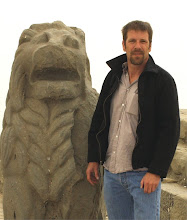 And now it is later... suffering the repercussion of extended vacations... an even more extended work load!
And now it is later... suffering the repercussion of extended vacations... an even more extended work load!Anyway, there is some odd fascination with these carved out tuff caverns, and an even more odd sense of calm. Taking time to sit and contemplate just how complex the lives of the early population really were is one of the most humbling of experiences. Turning off the flashlight, sitting in total darkness, unsure if your eyes are even open, inhaling the cool, somewhat musty air and hearing nothing, letting your mind go still - bliss is the only word that can even remotely describe the feeling. And personally, pure relief! No technology slapping me in the face. No cell phone to interrupt the moment. No boss to create some meaningless task, no client to come up with some senseless need, no computer to bombard me with one form of media or another, no whiny doctor or clinician (not that any of our staff whine) to beg a favor, simply relief, the opportunity to appreciate and bask in one forgotten element of every life - just being.
Eventually you have to turn that flashlight back on and continue on, but every trip provides me with some way to find that one moment, or in the case of this vacation, several of those moments.

Climbing in the dark along some crumbling stairs, not certain how many levels up, reveals the pigeon hutch, as common in these cave communities as a Starbucks on nearly every street corner, although it is difficult to see the ancient Turks ordering up ,"martı gübresi , venti please." This version of guano was, however, instrumental in the local agriculture and a very important resource.
 Soon it was time to go outside and skirt the hill that housed this complex. The more time spent in the cave rooms meant fewer hours of daylight to find my actual destination, plus there was still so much more to see.
Soon it was time to go outside and skirt the hill that housed this complex. The more time spent in the cave rooms meant fewer hours of daylight to find my actual destination, plus there was still so much more to see.Tramping along a hillside path, the nice man who had taken my money at the cave entrance was returning from tending his vineyard. Fortunately for me, language barriers have never been a concern, and the nice man seemed only too happy to show off his tiny patch of farmland.

Through a series of gestures and actual demonstration he was able to get across the message of his methods of cultivation. It was interesting to note that though maintained in what appeared to be a traditional manner, and looking at the accessibility issues and small size of the area, there were traces of ag chems (an empty bag of rebranded fertilizer used regularly here in California, and apparently commonly in the middle east too!) and soil amendments. What escapes me is the effort that he puts into bringing these additives to the location yet he still waters by hand when the terrain is a perfect fit for drip irrigation. This will be a question for the next visit! Another interesting thing was the texture of the soil surrounding the cultivated plot. It was a feeling of powdery tuff, but not chalky, and a mixing of clay. It really wasn't like the silt expected from years of erosion and decomposition. Not an easy texture to explain, it just needs to be touched.

No comments:
Post a Comment